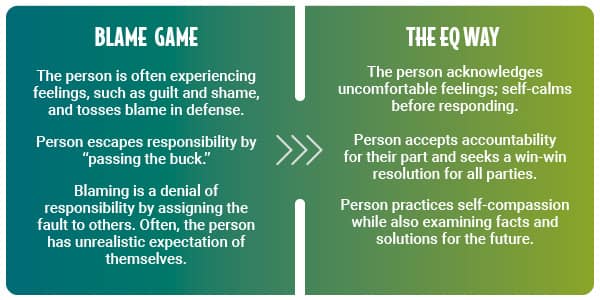We are all too familiar with the blame game. When we’re upset or exasperated in life, blaming our spouse, child, friend, or boss is an easy route to relief.
You know the drill: “If you wouldn’t procrastinate fixing things around the house, then I wouldn’t nag.”
Or if you weren’t so sensitive, we could discuss things calmer.”
And sometimes a person moves to name-calling: “You’re so frustrating or selfish or hurtful or ….”
Estimated reading time: 6 minutes
Table of Contents
Why Is Blame So Prevalent?
What Blame Looks Like in the Brain
Why Do We Blame Others?
Is Your Need to Be Heard Being Thwarted?
How to Deal with Someone Who Blames You
TIP 1: Flip Blame on Its Head with Understanding
TIP 2: Disrupt the Pattern
Comparison Chart - Blame vs an Emotionally Intelligent Response
TIP 3: Empathize with the Person
Empathetic Responses
How to Set Boundaries When Necessary
Closing Thoughts
Frequently Asked Questions
Why Is Blame So Prevalent?
Because it’s easy.
In the moment, we feel a release of pent-up energy and uncomfortable emotions.
But the thing is, I’ve never heard anyone say they enjoy being blamed or that they liked hurting someone’s feelings with blame.
Blame creates distance, strife, hurt, and ongoing conflict. And it doesn’t change anything for the positive.
Blame is common because most people have never been taught what blame really is and what to do differently (it’s shame, but more on that later).
Blame allows us to avoid painful and often vulnerable emotions. We skirt the real issue. Through blame, we dodge the responsibility that requires us to come to terms with what we may have done or painful memories being triggered from our past.
Blame eclipses our action to advocate for what we want, which gives us more of the same in the future.
So, next time you blame, ask, “What am I not taking responsibility for?” or “What do I want instead?”

What Blame Looks Like in the Brain
Often our first response when confronted by someone, especially when we’re caught off guard, is to protect.
Why?
This little almond-shaped amygdala in the brain signals a threat and sparks fear. The small group of nerves located in the brain’s temporal lobe is involved in processing stimuli internally (emotions and memories) and outside of the body, which then tells the brain how to respond to an experience. It’s like a sensitive mousetrap that releases the snap, and we react. That's why self-regulation is so important.
Why Do We Blame Others?
A big reason we blame is due to underlying shame. When we are feeling helpless or vulnerable, blame can protect us.
Another reason we blame others is to maintain the illusion of control. If I perceive myself in control, it is an artificial way to feel safe. However, we cannot control another human being or the circumstances of life.
Blame can also be fueled by the desire to be right. When we are clinging to being right or an unrealistic expectation of perfection, there’s no room for mistakes or anyone else’s perspective and feelings. We have shut the doors of our mind and heart. Our need to feel heard comes into play; we desire to be seen accurately for who we are and acknowledged for our unique experiences. This need to be heard means that in the heat of the moment, we value being right over being loving.
Is Your Need to Be Heard Being Thwarted?
Sometimes we just aren’t ready to hear someone else before we feel heard. And when that’s true, a standoff begins. Our basic human needs compete with the needs of our partner or the other person. This conflict ignites emotions on both sides, resulting in a standoff. I often tell couples that I work with: “If you’re not feeling heard, your partner isn’t feeling heard either.”
A major key to preventing blame or knee-jerk reactions to blame is to understand and process our emotions. Emotions quickly dissipate if we identify them and allow ourselves to feel them. Emotions show us how we are interpreting our experience and what action we need to take. Once we can slow down our reactions and regulate ourselves, we have a chance to respond from a more loving space.
Related reading: “Look What You Made Me Do!” How to Avoid the Blame Game.”

But how do we respond when we are blamed by another person? And how do we deal with the feelings of righteous indignation that rise up inside of us?
TIP #1 – Flip blame on its head by understanding.
To get out of the conundrum that the blame game creates is to turn blame into understanding. To accomplish this, first, push your pause button. Take time to calm yourself. Next, call to mind what you love or respect about the person. This process helps our emotions slow down and prevents a knee-jerk reaction. Once you’ve found your solid ground and calm space, you can seek to understand the other person.
When the brain’s spark plugs miss a connection to our heart, children and adults alike “misbehave.” And why do we lose that connection? Because emotionally, we are in fight, flight, or freeze due to a perceived threat. The amygdala has sounded the alarm. Notice I said perceived threat. It may not be a real threat, but the evidence gathered through our collective experiences is telling us we are in danger. The danger of being hurt, shamed, made wrong, humiliated, or alienated. As adults, we aren’t actually in danger, but old memories make us feel like we are.
TIP #2 – Disrupt the pattern, no matter how small the action.
For most of us, reacting to blame or blaming has become a habit—our default reaction to conflict.
I’ll never forget when a client creatively used this advice. Her husband would often pretend to listen, occasionally nodding while reading the newspaper as if he were listening. She’d feel infuriated and often blame him. She felt like he didn’t care about what she had to say. His half-hearted response was especially troublesome if she had something of importance to share.
So, the next time it happened, instead of blaming him for not listening, she just laid down on the floor in the dining room next to his chair. The action was so unexpected that she immediately got her husband’s immediate and full attention.
Then she was able to ask for what she wanted in the future without any blame or nagging. From that point on, they were able to interact differently. (In fact, he wondered why she didn’t let him know what she needed sooner.) She took an action that was so absurd it shattered a long-term pattern in their marriage.
However, your new action doesn’t have to be drastic. Any new behavior from either side will help redirect an old pattern and open the door to a better result.
Be open to baby steps that can disrupt a worn-out habit.
“Aim to Understand” is the new game. It is difficult at first, but the more you practice shifting to a proactive response, the less we feel the need to blame or defend.

Tip #3 – Empathize with the person.
Nothing deflates strong emotions—or blame—faster than empathy.
Seeking to understand, as we mentioned above, is only the first step. The next step is letting the person know they have a right to their emotions. Empathy isn’t agreement or validation for how they are acting. It merely says, “I understand you’re feeling vulnerable (or angry or frustrated) right now, and I’m here to support you.”
So, next time you hear yourself say internally, “He just doesn’t understand!” or “She always wants to be right!” remember that you hold the potential to turn arguments into understanding and closeness.
Just like magnets that repel or attract due to their poles, relationships are similar. We are either repelling or connecting.
It only takes one of us to flip to turn resistance to attraction and connection. And yes, it is that simple. And no, I didn’t say it was easy.
Empathetic Responses (examples you can use).
You can respond empathetically in many different ways. Here are a few:
- “Wow, I had no idea that you felt it was my responsibility to plan our vacation. Didn’t you say you wanted to plan it?”
- “You sound upset. What is it you want?”
- “Looks like this situation is difficult for you. Is there something you can do to feel better?”
- “You’re angry. Have I done something to hurt you?”
Deep dive into empathy: “What Is Empathy and Why Is It Important?”
Set Healthy Boundaries When Necessary
And when necessary, set healthy boundaries if blame gets out of hand.
For example, “I’m unwilling to be blamed for . When you calm down, I’d be happy to discuss it.” Or “Whoa, that’s not how I see it. Let’s both calm down and then circle back to talk about it.” Or "I take responsibility for , and I'd like you to take responsibility for your part. Let's calm down, then talk."
.jpeg?width=212&height=302&name=Woman-with-pinching-heels_Compressed_AdobeStock_85452872%20(1).jpeg) Closing Thoughts
Closing Thoughts
Just like a new pair of shoes, these suggestions might seem strange and uncomfortable at first. They might even pinch a little.
They just need to be broken in until you’re comfortable with them.
Allow your mind to stretch!
Take time to get accustomed to new ideas and responses. Wear the new thought or behavior for a while. Seek to understand where the other person is coming from and ponder what it would be like to think and feel that way.
As we gain new skills and perspectives, we begin to lose the need to blame or defend when someone else blames us. When we realize that blame is shame turned inside out, it allows us to have more compassion for ourselves and others. And then, when each of us is in a safe space, we can voluntarily choose to take responsibility.
Related reading: “How to Get Past Blame and Shame and Strengthen Your Relationship.”
Frequently Asked Questions
Why do I keep blaming myself for everything?
Often, it's safer to blame ourselves than to release anger toward another person. And sometimes when we blame ourselves, we can have too high of expectations of ourselves.
When I was a young mother and felt overwhelmed or stressed, I'd react with blame when something went wrong. It felt awful! So I investigated what I was feeling when I blamed myself (or others).
What I discovered was that I had unrealistic expectations of myself, expecting myself to work full-time, be a super mom of three young children without meeting my own needs. Add to that a serious case of perfectionism, I was a hot mess. I didn't give myself grace to be human.
Are you asking, "How do I stop self-blame and guilt?"
My remedy: self-acceptance.
When we blame ourselves repeatedly, it becomes an unconscious habit. So the same advice above works: interrupt the pattern.
For me, my belief of "I am never enough" fueled guilt and shame. So the first thing I did was practice self-acceptance. It was hard at first. And the negative emotions didn't evaporate right away but the more I practiced being kind to myself, the more the inner critic was silenced.
When you blame yourself, stop and ask what you have done well that day. Or find the ways you are expressing understanding and tolerance.
For personalized support to build healthier habits and boundaries, contact Heartmanity.
Or check out our emotional intelligence course for practice with some of the skills mentioned in this blog.










